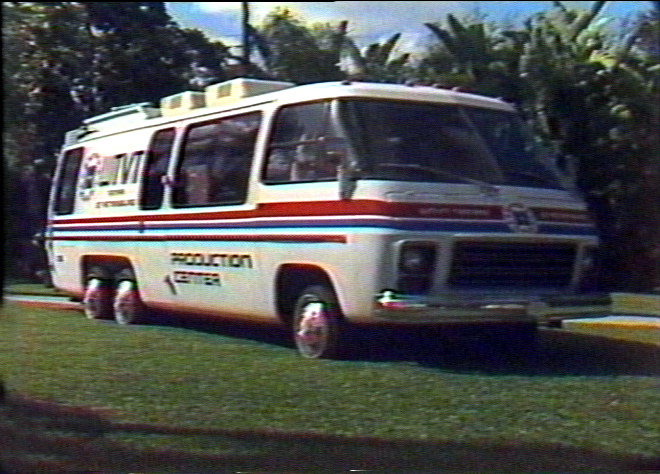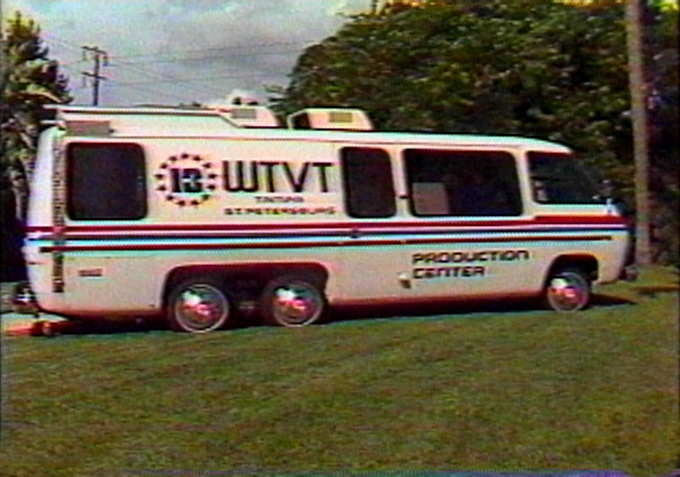
On The Road Again...

Sleek, sassy, and loaded with 2 Hitachi cameras and 2 VTRs.
Another mobile innovation occurred in 1976 when WTVT converted a General Motors Motorhome recreational vehicle into use as a remote truck. The RV was equipped with two new-generation portable Ikegami HL-33 color cameras, combining ENG-style shooting with conventional production techniques. The cameras could be hand-held or mounted on tripods with complete headphone communication to the director's console.
 |
 |
 |
| An Ampex AVR-2 Quad VTR sits behind the driver | The director's station faces towards the bow |
Two cameras meant a pretty simple switcher |
 |
 |
 |
|
Ampex AVR-2 was backed up by a portable VR-3000 |
Hitachi HL-33's meant hand-held video |
Nothing sleeker than WTVT's GMC Motorhome |
A small quad VCR, the Ampex AVR-2, was permanently installed inside the RV, while a second VTR, the Ampex VR-3000, was capable of being removed from the RV and used on site. The director switched cameras from a small Grass Valley special effects generator. The new RV was used for commercial production, some 'event' live news feeds, a regular church program taped on location at a local congregation, and for recording promotional spots in various bay area locales.
Chief Engineer Frank Rankel and his corps of engineers
kept the
studios and mobile units humming
End of the Road
By the late 1970s, the aging mobile unit was in constant need of repair and maintenance. Since the cab and trailer were permanently joined, a breakdown of the engine would cripple both. A new cab and trailer were purchased and work began to create the next generation mobile unit but a laundry list of improvements from the networks would present the station with a stratospheric bill for updating the unit to their specifications. Gaylord management decided the cost would be too much and got out of the remote unit business. At the same time, smaller and more cost efficient production companies were opening in the Tampa Bay area. Using portable Betacam units and boutique style editing systems, these local producers lured commercial clients away from Channel 13's studio.
Engineer Bill Napier in the cab of WTVT's last mobile unit,
which was never completed.
Studio 13, which was dedicated to commercial shoots and pre-recorded programming, was eventually shuttered, and the new, unfinished mobile unit was sold to Turner Broadcasting who completed the construction.
At that point, Channel 13 was essentially out of the production business.
The mobile unit's recently installed Philips LDK-25s were moved into the studio in 1980, and equipped with permanently mounted Teleprompters.
Epilogue
Financially, the reasons for Channel 13 leaving the mobile unit business were sound but it took away something that was a significant part of the station's character. In its heyday, the mobile unit put WTVT and its viewers in the front row for local and national events. The promotional benefits of the mobile unit and its visibility to the public helped foster the impression that the station was truly connected to the community. While the use of ENG units, satellite trucks, and a helicopter mitigated the loss of the mobile unit, other stations in the market had similar equipment and Channel 13 could no longer claim supremacy in remote coverage.